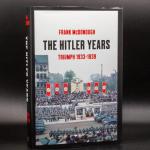The Hitler Years: Triumph, 1933-1939, Frank McDonough
Frank McDonough’s The Hitler Years: Triumph is the first volume in a two-part series on Hitler and the Nazi Party’s government of Germany. Covering the period 1933 to 1939, it charts the rise to power of Hitler, the political wrangling that turned him into Chancellor and the swift decline of democracy thereafter, through to his invasion of Poland and the subsequent diplomatic fall-out in a detailed narrativeA story; in the writing of history it usually describes an approach that favours story over analysis.A story; in the writing of history it usually describes an approach that favours story over analysis. . This will later combine with a second volume covering the war years to provide a definitive history of the Third ReichLiterally meaning the third realm or empire. It is the name used to describe Nazi Germany, from 1933 until 1945.Literally meaning the third realm or empire. It is the English name used to describe Nazi Germany, from 1933 until 1945..
Many people might wonder why a new narrative history of the Third Reich is necessary – there are so many lining the bookshelves already – and the cynical could suggest that McDonough is simply milking the cash cow. But McDonough’s approach is genuinely new: his exact focus and his strict adherence to a chronological narrative reveal interesting insights and a different view of the regime. As he rightly says in his introduction, the old arguments of structuralist versus intentionalist are tired and reductive, and can’t possibly be successful in explaining every aspect of the twelve-year Reich. Instead, he suggests a middle path: that Hitler did have a plan, but that he was flexible and imaginative enough to respond to events as they happened. He was, in fact, considerably more so than the ‘obstinate and dogmatic’ Chamberlain, who comes in for considerable, although fair, criticism in the latter half of the book. P. 451. To someone who last considered the historiographyThe study of writing history, or of history that has already been written.The study of writing history, or of history that has already been written. of the Third Reich twenty years ago, this is a refreshing – and surprising – suggestion. What is even more surprising is that the theory is backed up throughout the book in a thoroughly convincing manner. The style of writing - the dedication to listing seemingly unconnected events in the order in which they happened - while occasionally jarring in the first part of the book, distances the reader from the inevitability of the Final Solution and 1945, reducing hindsight and the sense of determinism. Instead, it brings to mind the proverbial boiled frog: from a slow start, in which Hitler in public presented himself as a thoroughly reasonable and restraining force, events accelerate through various internal and international crises to lead to the outbreak of the Second World WarA global war that lasted from 1939 until 1945.A global war that lasted from 1939 until 1945. . Everything about the Hitler regime - how he was allowed into power in the first place, why Jewish people didn't leave before it was too late, why Chamberlain persisted in believing that he could obtain a negotiated peace - thus becomes that little bit more understandable. Throughout the book, Hitler is shown not only as the convincing, charismatic leader – which we knew already – but as someone willing to change his short-term outlook for long-term ends, and as someone adaptable enough to turn potentially crushing defeats into resounding victories. He did not just act to initiate events, but reacted to them in such a way as to give him the advantage.
P. 451. To someone who last considered the historiographyThe study of writing history, or of history that has already been written.The study of writing history, or of history that has already been written. of the Third Reich twenty years ago, this is a refreshing – and surprising – suggestion. What is even more surprising is that the theory is backed up throughout the book in a thoroughly convincing manner. The style of writing - the dedication to listing seemingly unconnected events in the order in which they happened - while occasionally jarring in the first part of the book, distances the reader from the inevitability of the Final Solution and 1945, reducing hindsight and the sense of determinism. Instead, it brings to mind the proverbial boiled frog: from a slow start, in which Hitler in public presented himself as a thoroughly reasonable and restraining force, events accelerate through various internal and international crises to lead to the outbreak of the Second World WarA global war that lasted from 1939 until 1945.A global war that lasted from 1939 until 1945. . Everything about the Hitler regime - how he was allowed into power in the first place, why Jewish people didn't leave before it was too late, why Chamberlain persisted in believing that he could obtain a negotiated peace - thus becomes that little bit more understandable. Throughout the book, Hitler is shown not only as the convincing, charismatic leader – which we knew already – but as someone willing to change his short-term outlook for long-term ends, and as someone adaptable enough to turn potentially crushing defeats into resounding victories. He did not just act to initiate events, but reacted to them in such a way as to give him the advantage.
Hitler’s inflexibility isn’t the only myth that is busted in the book: his ‘refusal’ to shake the hand of Jesse Owens, the Polish cavalryPeople fighting on horseback, who were therefore more mobile than foot soldiers. In modern warfare, the cavalry are those fighting in armoured vehicles.People fighting on horseback, who were therefore more mobile than foot soldiers. In modern warfare, the cavalry are those fighting in armoured vehicles. charge against German tanks, the considerable increase in German standards of living, among many others – all of which I was taught to consider as facts at school – are shown to be false, or at least propagandaBiased and misleading information used to promote a political cause or point of view.Biased and misleading information used to promote a political cause or point of view.-twisted versions of the truth. And although McDonough often doesn’t engage directly with historiography – few theories and names are mentioned within the main narrative – he does highlight areas of contentionHeated disagreement, or an argument.Heated disagreement, or an argument. throughout the text, and makes effective use of the endnotes to further the discussion. These endnotes also show just how exhaustive McDonough’s research has been, and this is visible in the text: he has not limited himself to the usual sources for a political history, but has included eye-witness and contemporarySomeone or something living or occurring at the same time. interviews, press reports, war-trial evidence, and a range of letters and memoirs. These are complemented by a huge amount of visual evidence, carefully selected and placed throughout the text, further bringing the narrative to life.
This first volume of The Hitler Years is not therefore just another popular history with nothing new to say, and no contribution to make. It is a masterclass in the history of Nazi Germany, with an internationally renowned expert as the teacher. It is clever, it is refreshing, it is convincing. It is also essential reading for any history student intending to study the Third Reich at any level. I only wish I’d had access to such a comprehensive, detailed, and well-considered book when I was studying Nazi Germany.
- Log in to post comments







